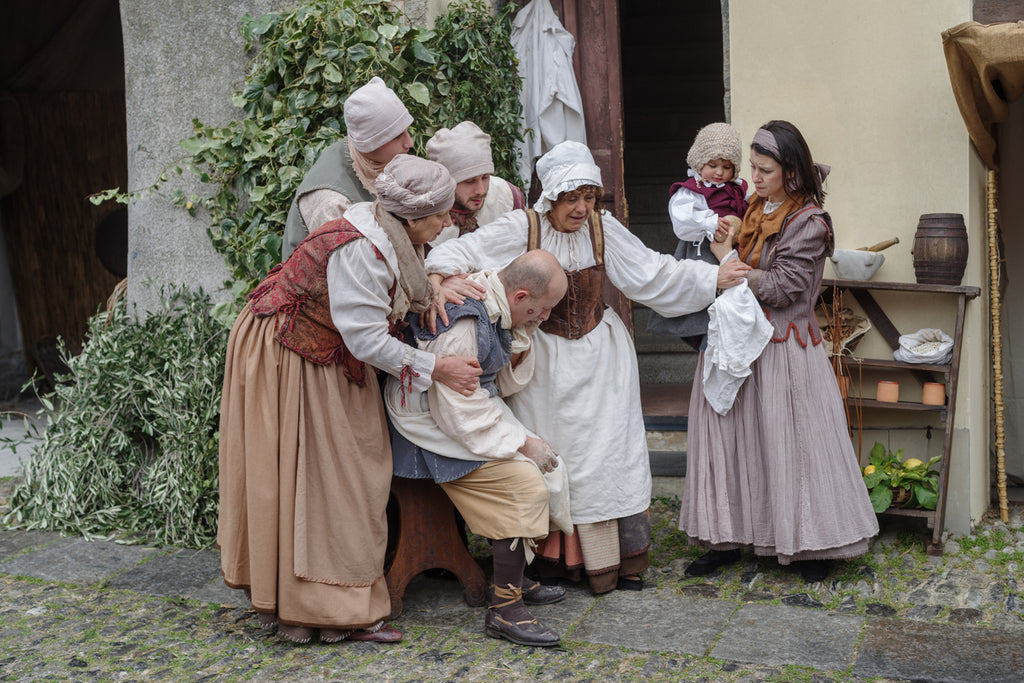Your Cart is Empty

During the Renaissance, a period bursting with artistic and intellectual awakening, even peasant clothing held its own charm and functional design. Today, we're diving deep into what peasant women wore, their material choices, everyday attire, and how they dressed for special occasions. Whether you're a history buff or a fashion enthusiast, this guide to renaissance fashion will shed light on the often overlooked aspects of Renaissance wear - so let’s dive in!
The fabric of life in the Renaissance for peasants was simple and dictated by the resources available to them. Unlike the luxurious silks and velvets adorning the nobility, peasants relied on more durable and accessible materials like wool, linen, and hemp. The garments were often made at home, with women spinning the thread and weaving the cloth themselves, and this not only made the clothing highly sustainable but also infused it with a personal touch that’s often hard to find in modern fashion. But you can in fact shop high quality Renaissance dresses now - at Holy Clothing, all of our dresses are custom designed and handmade to size, so you can truly feel like you’re back in the Renaissance period at your next costume party or ren faire!
Peasant women’s daily wear was practical yet subtly stylish; a typical outfit included a long linen chemise that served as the base layer, topped with a woolen skirt or dress. To combat the chill, they added woolen shawls or cloaks, which were both functional and a chance to display some personal style through color or simple embroidery. Leather shoes or wooden clogs were common, providing the necessary durability for daily labor.
The workwear of peasant women had to withstand rigorous daily tasks, and durability was key; this meant that garments were often loose-fitting to allow freedom of movement and were reinforced in areas prone to wear. Aprons were ubiquitous, not just as a protective layer but also as a convenient way to carry tools or harvested crops. Hats and bonnets also protected their skin from the harsh sun during long hours in the fields.
Even in the simplicity of peasant life, festivals and holy days were times for joy and a bit more adornment; during such events, peasant women often wore their best tunics or gowns, which were typically a brighter color or a finer weave than their everyday clothes. These garments were sometimes accentuated with ribbons or a modest piece of jewelry, like a brooch, showcasing that everyone finds a way to sparkle, no matter their station in life.

The Renaissance period spanned all across Europe, and this meant that peasant clothing varied significantly from one region to another. For instance, Italian peasants favored brighter colors and lighter fabrics compared to their Northern counterparts, who needed heavier materials to withstand colder climates.
While peasants were far from the fashion trendsetters of the Renaissance, they weren’t entirely isolated from the broader changes in fashion; the gradual simplification of lines seen in noble attire, along with a shift towards more comfortable and practical clothing, trickled down to peasant fashion over time, showing us that fashion trends aren’t a modern invention, but a testament to the interconnectedness of society, regardless of class distinctions.
Renaissance peasant fashion offers us a glimpse into a past where fashion was deeply intertwined with daily life and regional characteristics; and perhaps more than anything, it reminds us that style exists in every stratum of society, influenced not just by necessity and occasion, but by passing trends and social expectations.
While peasants generally wore more subdued colors due to the limitations of natural dyes and the need for practicality, certain regions showed preferences for specific colors or patterns. For example, in some areas, blue and gray were common due to the availability of local plant dyes. Patterns were usually simple, reflecting the weaving techniques of the time, such as basic checks or stripes.
Age influenced the style and function of peasant clothing. Younger women often wore shorter skirts and brighter colors, reflecting their unmarried status and vitality. Married women adopted longer skirts and darker, more subdued colors as a sign of maturity and respectability. Elderly women wore additional layers for comfort and warmth, often in the form of shawls and caps.
Accessories were both functional and decorative. Women commonly wore headgear like bonnets to protect from the sun and to keep hair clean from dust. Belts were essential, used to hold tools or to tuck up skirts for easier movement. Small pouches or bags attached to belts held personal items, seeds, or even snacks for long days of work.